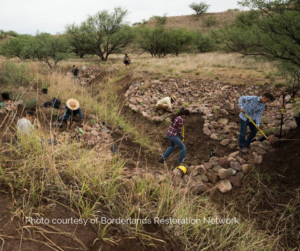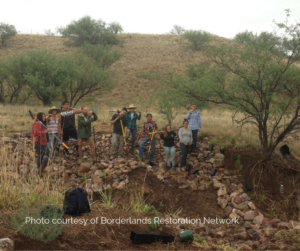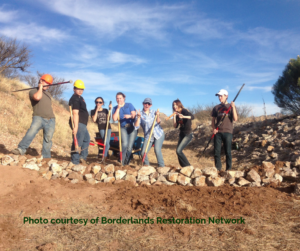Weavers in the Age of Restoration:
The Beginnings of an Ecological And Social Renaissance
I recently read a much needed uplifting opinion piece by David Brooks titled “A Nation of Weavers: The social renaissance is happening from the ground up.” In it, Brooks describes the societal epidemic of social isolation, fragmentation, and lack of connection; the inability “…to see the full dignity of each other, and the resulting culture of fear, distrust, tribalism, shaming, and strife.” It struck me as ironic that while Brooks’ assertion is generally true, it comes at a time we in the US are living in the most materially wealthy moment in human history.
Sociologists, economists, and others have reported that although GDP has tripled since 1960, measures of happiness have not increased; in fact, happiness in the US has gotten worse in recent years, even as per capita GDP continues to rise. Rates of depression, obesity, and suicide are at all-time highs, all unaccounted for by our antiquated economic system. More on that later.
Community Leaders (aka ‘Weavers’) Build Relationships
Brooks goes on to describe his recent travels around the country encountering “Weavers”, community leaders working quietly to build relationships within their local communities; putting we over me. “We don’t do things to people. We do things with people”, a woman who builds a community for teenagers in New Orleans told Brooks. “The big question” according to Brooks “is how do we take the success Weavers are having on the local level and make it national?” He concludes that Weavers build relationships one by one, which doesn’t scale very easily.
On the other hand, there is a pressing need each of us has to take care of our health. What if this otherwise selfish need caused us to engage with others? What if we, working together for selfish aim, unselfishly weave back together an incredibly important constituent of our world? And what if this opportunity were right outside our door? Such an opportunity could scale immediately.
Related Blog: Economic Impacts of Climate Change
Ecological Restoration is the New Frontier

A rock crew of “Weavers”, building erosion control structures, restoring a degraded streambed. Photo courtesy Borderlands Restoration Network.
A friend of mine, Gary Nabhan, recently wrote a very interesting article in Earth Island Journal. In it, he mentions that Martin Breed, a professor of restoration ecology and genomics at the University of Adelaide, Australia has observed that “urban restoration is the new frontier…and fortunately, the healthiest thing you can do in this world is to get physically engaged in ecological restoration.” It turns out that gardening (with native plants please), planting trees, getting rid of meticulously kept lawns, and just simply getting your hands dirty with soil and the microbes within has the equivalent effect on a person’s health as an increase in socioeconomic status, one study found.
Social and Personal Benefits Come From Working With Others
Working in and restoring soils also helps to solve an array of public health problems: depression, obesity, allergies, attention deficit disorders, and autoimmune disease among them. Research shows that by restoring soil health we restore our own internal microbial communities and strengthen our immune systems, a win-win for nature and humans. And, there are additional social and personal benefits from positive interactions experienced when working with “others” of different races, classes, faiths, or political views. Native-American ecologist Robin Kimmerer calls this reciprocal restoration: “As we work together to restore our homelands, we ourselves are restored”.

A diverse group of community members finding common purpose through sharing the hard work of watershed restoration. Photo courtesy Borderlands Restoration Network.
Opportunities abound: many able-bodied Americans simply need jobs. And let’s not forget Americans generally, who spend 90% of their time indoors; they need to get out and join in. Or when a court orders a “truant” youth, petty criminal (think DUI conviction or white-collar investment banker) or non-violent prison inmate to do community work to atone for their misdeeds, they could join a work crew of restoration ecologists sowing pollinator meadows, planting trees, building erosion control structures to hold soil providing safety from flooding, among many other benefits. Perhaps this life-affirming approach offers a way out of social isolation and recidivism through invitation to rejoin community doing productive work.
Biophilia Foundation Supports Communities of Weavers
The Biophilia Foundation supports a number of Weavers. In Mexico, our partnership with the Cuenca Los Ojos Foundation is working to establish a native plant nursery to supply ongoing restoration of grasslands and previously denuded riparian areas. Just across the border in Patagonia, Arizona we helped establish the Borderlands Restoration Network, which works with local communities, youth, and tribes to slow and capture water, re-attaching incised streams to their floodplains, critical to this arid landscape. Besides citizens and youth, work crews also involve prisoners, giving them a chance to experience restoration and hope. The following is a description restoration ecologist and prisoner work crew leader David Seibert sent me:
The first day set the stage and tone. We visited previously built rock erosion control structures—low, dry-stacked rock filters that slow water and retain sediment and moisture—and talked about how they function in tandem with one another to stitch degraded watersheds back together and improve resilience. We emphasized the utility of the work and its importance in context, along with three key points that received many nods from the crew—they would be treated with respect as employees and allies while in the field; our collective name would be on each structure, and so we required high-quality work; and we would approach the effort not as busywork, but as work with a purpose. “Good!” said one of the men, and we got after it.
About half-way into the first day of building, one of the team passed me on the way to refilling a water bottle, smiling broadly and shouting, “This is cool, man!” I continued to demonstrate techniques, check the quality, make corrections, and quiz the men on how and why we were making specific moves with the rock, wood, and soil at hand. Nicknames like Grumpy, Foreman John, Jarhead, and Bryan With a Y soon filled the air, along with plenty of expletives, competitive joking, and critiques among the crew. Within days they were comparing one another’s work and were quick to take credit for any functional structure and defend their moves, but there was more than rockwork and habitat resilience taking shape here. On a tour of one arroyo complex soon after the first rain event, Grumpy suddenly blurted out with surprise in his voice, “At first I was like, what is this?! No way this is going to work. But then when I seen that stuff [moisture and organic material captured behind one of his intact structures], I tell ya I stood a little taller.”
Related Blog: From Sophists to a New Pedagogy: Using Nature to Break Free
Ecosystem Restoration Provides a Good Rate of Return
Unfortunately, there are voices in our society who don’t support green infrastructure initiatives like this because they claim, the costs are too high, although public works that pave over paradise remain popular. Regardless, in addition to measures of public and community health that even our traditional economics can measure, such as lower public health costs, fewer suicides, less drug and alcohol abuse, and decreased costs of violence, there are other substantial benefits upon which this public policy can stand. Restoring and stabilizing soil sequesters about 50% carbon by weight, a huge amount of climate mitigation that is becoming increasingly priceless. In fact, research indicates that in terms of ecosystem restoration, investing $1 earns at least $10 in direct benefits and up to $36 when non-market social values are considered. Not a bad return.

Saving the world on any scale can be fun, too! Photo courtesy Borderlands Restoration Network.
There’s Still Time to Save And Restore our Planet
As David Brooks observes, “culture changes when a small group of people, often on the margins of society, find a better way to live.” Weavers have found a better way to live. To put a finer point on it, the man who popularized the concept of biophilia, E.O Wilson, once said: “there can be no purpose more inspiring than to begin the Age of Restoration, re-weaving the wondrous diversity of life that still surrounds us.” I struggle, but remain hopeful, that we still have time to restore the health of our planet and ourselves, while at the same time making our societies more just and equitable.

Recent Comments